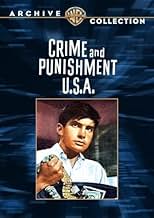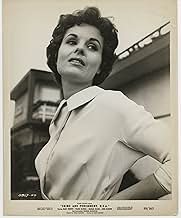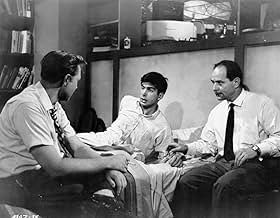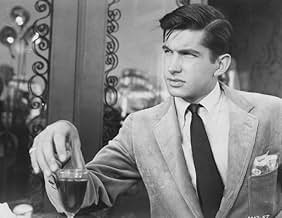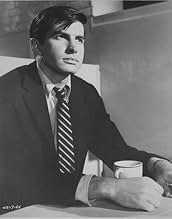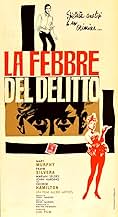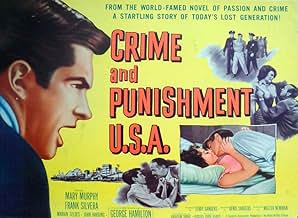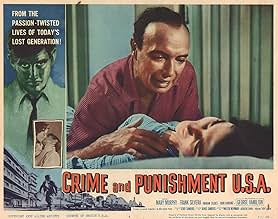Ajouter une intrigue dans votre langueA Californian law student murders a pawnbroker, then matches wits with the detective on the case.A Californian law student murders a pawnbroker, then matches wits with the detective on the case.A Californian law student murders a pawnbroker, then matches wits with the detective on the case.
- Réalisation
- Scénario
- Casting principal
- Nomination aux 1 BAFTA Award
- 2 victoires et 1 nomination au total
Tony Johnson
- Mrs. Cole
- (as Toni Merrill)
Sidney Clute
- Doctor
- (as Sid Clute)
James Hyland
- Man in Coffee Shop
- (as Jim Hyland)
Avis à la une
I haven't seen this movie for more years than I care to remember. It was released accompanied by sensationalistic contemporary tag lines -- "Beatniks! Rebels!" -- partly because George Hamilton is seen playing the bongos once in a while. Yet, it has stuck in my memory. It really was an unusual film.
First of all, Dostoyevsky is rather awkwardly superimposed on a story involving residents of modern L.A. The novel doesn't quite fit on the setting. People have serious conversations about God and the afterlife. Okay for a 19th-cntury Rusian novel -- but sunny California? Home of the Fountain of the World Cult?
And it always bothered me about the novel that everyone in Petersberg seems to be acquainted with everyone else. It was a bit difficult to swallow that proposition in the novel; it is absolutely impossible for that to have been true in L.A. circa 1960, the most anomic community on the face of the planet. But instead of being an irritation, the lack of fit between the plot and its contemporary setting lends the film an unquiet, almost surreal quality. Something is off kilter and we don't know exactly what. We squirm with bemusement.
Two points ought to be made. The movie must have been shot on the cheap. In this case, it inadvertently helps. We are given a tour of the seedier sections of L.A. -- railroad tracks, refuse dumps, shabby housing -- that a better-funded film would probably have avoided. Instead of Echo Park we get a slum. This is commonplace now, but it wasn't at the time. It's too bad nobody in California seems to know what a genuine slum looks like. Here it's all a sun-drenched, palm-fronded, flower-strewn paradise, however desecrated. They should have set it in Newark. And they needn't have used high-key lighting so consistently. It looks like an early television sitcom.
Second, the acting is actually quite good. I am even willing to forgive George Hamilton's handsomeness. (He's always been willing to poke fun at himself anyway.) Mary Murphy is not the young naif she played in "The Wild One." She's not exactly a hooker either, as she was in the novel. In 1960 neither audiences nor agents of social control were prepared for that. But she is a serious kind of easy lay, which was still saying a lot. Best of all is Frank Silvera. The smooth admirable way in which he insinuates himself into Robert's life. The cat and mouse repartee. The wondering expression on his face, his amazement that Hamilton has not yet caught on, as he tells him who committed the murder -- "Why YOU did, Robert."
I don't know how I would respond to the movie now, lo, these many years later. But, crude as it is, it's not just a shoddy ripoff of a famous psychological drama. It would be a mistake to think so. If all the elements of the film are amateurish, as in a high school play, the people involved seem to be hitting the right notes by accident. This is worth catching, a real curiosity.
First of all, Dostoyevsky is rather awkwardly superimposed on a story involving residents of modern L.A. The novel doesn't quite fit on the setting. People have serious conversations about God and the afterlife. Okay for a 19th-cntury Rusian novel -- but sunny California? Home of the Fountain of the World Cult?
And it always bothered me about the novel that everyone in Petersberg seems to be acquainted with everyone else. It was a bit difficult to swallow that proposition in the novel; it is absolutely impossible for that to have been true in L.A. circa 1960, the most anomic community on the face of the planet. But instead of being an irritation, the lack of fit between the plot and its contemporary setting lends the film an unquiet, almost surreal quality. Something is off kilter and we don't know exactly what. We squirm with bemusement.
Two points ought to be made. The movie must have been shot on the cheap. In this case, it inadvertently helps. We are given a tour of the seedier sections of L.A. -- railroad tracks, refuse dumps, shabby housing -- that a better-funded film would probably have avoided. Instead of Echo Park we get a slum. This is commonplace now, but it wasn't at the time. It's too bad nobody in California seems to know what a genuine slum looks like. Here it's all a sun-drenched, palm-fronded, flower-strewn paradise, however desecrated. They should have set it in Newark. And they needn't have used high-key lighting so consistently. It looks like an early television sitcom.
Second, the acting is actually quite good. I am even willing to forgive George Hamilton's handsomeness. (He's always been willing to poke fun at himself anyway.) Mary Murphy is not the young naif she played in "The Wild One." She's not exactly a hooker either, as she was in the novel. In 1960 neither audiences nor agents of social control were prepared for that. But she is a serious kind of easy lay, which was still saying a lot. Best of all is Frank Silvera. The smooth admirable way in which he insinuates himself into Robert's life. The cat and mouse repartee. The wondering expression on his face, his amazement that Hamilton has not yet caught on, as he tells him who committed the murder -- "Why YOU did, Robert."
I don't know how I would respond to the movie now, lo, these many years later. But, crude as it is, it's not just a shoddy ripoff of a famous psychological drama. It would be a mistake to think so. If all the elements of the film are amateurish, as in a high school play, the people involved seem to be hitting the right notes by accident. This is worth catching, a real curiosity.
Actually more like the previous years' COMPULSION than a modernization of Fyodor Dostoevsky's CRIME AND PUNISHMENT... although that's exactly what it is, by title, and if Frank Silvera's friendly, complimenting homicide detective is reminiscent of the 1970's TV-cop COLUMBO, both are based on the same literary character...
And ironically, George Hamilton became a victim-of-persuasion from both determined constables and here, resembling Anthony Perkins with the combined personalities of either COMPULSION killer... broodingly into Atheist philosophy while acting too good for everyone, in particular the earthy lawman... he's more aimless than guilt-ridden...
The grainy-B&W Los Angeles-set sequences between Hamilton's Robert and the affable yet clinging detective are no different in tone than existential conversations with deep-thinking heart-of-gold-hooker Mary Murphy, his best buddy (Wayne Heffney) or his sister's middle-aged fiance (seeming straight from an Actor's Studio workshop)... yet the overall stagey aspect's so upfront and natural, CRIME feels more intriguing than meandering...
And while never claiming to be a thriller, it's no melodrama either, fitting within a kind of Beatnik's soulless journey that... between the genuine street thug film noirs and the colorful counter-culture neo noirs... exists within the sharpened jazz-soaked cinema of the late 1950's, as unappreciated now as it was back then.
And ironically, George Hamilton became a victim-of-persuasion from both determined constables and here, resembling Anthony Perkins with the combined personalities of either COMPULSION killer... broodingly into Atheist philosophy while acting too good for everyone, in particular the earthy lawman... he's more aimless than guilt-ridden...
The grainy-B&W Los Angeles-set sequences between Hamilton's Robert and the affable yet clinging detective are no different in tone than existential conversations with deep-thinking heart-of-gold-hooker Mary Murphy, his best buddy (Wayne Heffney) or his sister's middle-aged fiance (seeming straight from an Actor's Studio workshop)... yet the overall stagey aspect's so upfront and natural, CRIME feels more intriguing than meandering...
And while never claiming to be a thriller, it's no melodrama either, fitting within a kind of Beatnik's soulless journey that... between the genuine street thug film noirs and the colorful counter-culture neo noirs... exists within the sharpened jazz-soaked cinema of the late 1950's, as unappreciated now as it was back then.
To begin with, I almost did not acquire this when I chanced upon it, since the film does not have much of a reputation; even so, it has recently been released on DVD-R as part of Warners' "Archive Collection", running 96 minutes (like the version I watched) rather than 78 as listed on the IMDb! In any case, the result is undeniably gripping (given the source material) and decidedly accomplished (in spite of the obvious low budget) – with gleaming cinematography by Floyd Crosby and a jazzy score by Herschel Burke Gilbert.
Best of all, the performances (notably, as always, the arrogant protagonist and his wily nemesis) are reasonably impressive. George Hamilton (being nominated for a BAFTA award in his film debut) kind of channels Anthony Perkins here, and it is unfortunate that he would soon forsake such thoughtful roles for sophisticated (and, in the long run, superficial) ones. Frank Silvera plays his pivotal cop role as something of a buffoon; Mary Murphy's character, then, does not shy away from discussing her sordid 'profession'; while John Harding appears as the seducer of the hero's sister. Incidentally, Hamilton's scenes with the latter two are only slightly less compelling than his confrontations with Silvera (established in previous cinematic renditions as the novel's centerpiece).
As the title suggests, Dostoyevsky's morality tale has been updated to modern-day America: curiously, it eschews the pivotal figure of the pawnbroker entirely (though we are still told why the murder was committed) – indeed, the narrative here starts off with the arrest of the painter! Still, the victim's essentially disagreeable characteristics are transferred onto the afore-mentioned Harding – which seemed unnecessary at first, but this does generate an intriguing complicity between the two murderers paid off, most effectively, in ironical fashion when the student ultimately confesses because he believes the other fellow killed himself out of remorse when it was over rejection!
In the end, the film is pretentious (boasting a powerful script by Walter Newman), with a tendency towards sleaze; that said, this mature approach is quite redolent of the transitional period in which it was made – being entrenched somewhere between studio-system Hollywood and the 'movie brats' generation. For the record, this was also director Sanders' first effort, of whose later work I have watched (and own) WAR HUNT (1962), ELVIS: THAT'S THE WAY IT IS (1970/2000) and INVASION OF THE BEE GIRLS (1973); besides, I have just acquired THE American WEST OF JOHN FORD (1971; TV) and am interested in ONE MAN'S WAY and SHOCK TREATMENT (both 1964).
Best of all, the performances (notably, as always, the arrogant protagonist and his wily nemesis) are reasonably impressive. George Hamilton (being nominated for a BAFTA award in his film debut) kind of channels Anthony Perkins here, and it is unfortunate that he would soon forsake such thoughtful roles for sophisticated (and, in the long run, superficial) ones. Frank Silvera plays his pivotal cop role as something of a buffoon; Mary Murphy's character, then, does not shy away from discussing her sordid 'profession'; while John Harding appears as the seducer of the hero's sister. Incidentally, Hamilton's scenes with the latter two are only slightly less compelling than his confrontations with Silvera (established in previous cinematic renditions as the novel's centerpiece).
As the title suggests, Dostoyevsky's morality tale has been updated to modern-day America: curiously, it eschews the pivotal figure of the pawnbroker entirely (though we are still told why the murder was committed) – indeed, the narrative here starts off with the arrest of the painter! Still, the victim's essentially disagreeable characteristics are transferred onto the afore-mentioned Harding – which seemed unnecessary at first, but this does generate an intriguing complicity between the two murderers paid off, most effectively, in ironical fashion when the student ultimately confesses because he believes the other fellow killed himself out of remorse when it was over rejection!
In the end, the film is pretentious (boasting a powerful script by Walter Newman), with a tendency towards sleaze; that said, this mature approach is quite redolent of the transitional period in which it was made – being entrenched somewhere between studio-system Hollywood and the 'movie brats' generation. For the record, this was also director Sanders' first effort, of whose later work I have watched (and own) WAR HUNT (1962), ELVIS: THAT'S THE WAY IT IS (1970/2000) and INVASION OF THE BEE GIRLS (1973); besides, I have just acquired THE American WEST OF JOHN FORD (1971; TV) and am interested in ONE MAN'S WAY and SHOCK TREATMENT (both 1964).
In California, Robert Cole (George Hamilton) collapses in front of the cops. He buries the evidence of his crime, but a dying man may have seen him. He takes the man back home to Sally. He had written an article stating that certain superior people can break the law which comes to the notice of the police. He is brought in for an interview.
This opens on Pacific Ocean Park in Santa Monica. The most fascinating part of this B-crime movie may be the locations. It's great to see the old California with all the oil rigs. It does have a young George Hamilton as the lead. He's fine, but he's never been a great actor. I wanted this to start as a darker noir crime thriller. Robert should leave the man to die on the side of the road. That's the darker start. It's interesting that Robert has his views. Otherwise, the plot drags and I don't really care about him. This is not as compelling as it should be.
This opens on Pacific Ocean Park in Santa Monica. The most fascinating part of this B-crime movie may be the locations. It's great to see the old California with all the oil rigs. It does have a young George Hamilton as the lead. He's fine, but he's never been a great actor. I wanted this to start as a darker noir crime thriller. Robert should leave the man to die on the side of the road. That's the darker start. It's interesting that Robert has his views. Otherwise, the plot drags and I don't really care about him. This is not as compelling as it should be.
George Hamilton stars with Marian Seldes and Mary Murphy in "Crime and Punishment USA," an adaptation of the novel by Dostoevsky, directed by Denis Sanders.
The film "introduces" George Hamilton.
Hamilton plays a young man who kills and robs a pawnbroker and later comes up against a smart police detective (Frank Silvera) who preys on his conscience.
The only other version of this I've seen is the Peter Lorre one from 1935 and as you might guess, this film doesn't compare, and comparing George Hamilton to Peter Lorre - well, it can't be done.
One thing both films have in common is that they were done cheaply, and both in black and white. The black and white serves both films very well. It made the places in this film look kind of low-class and gritty.
The atmosphere was really the only thing I liked. The music was very loud and had those screeching trumpets one always heard in the '50s and '60s in films.
I also thought everyone acted somewhat inappropriately. It's possible it all happened in the other film, but it was either done better or I just don't recall it.
When a man admits to killing someone, what would make a woman suddenly decide she wants to sleep with him? Especially after an uncomfortable scene where he yelled at her and acted rather weirdly.
Hamilton would be talking and suddenly start shouting -- it seemed like the emotions in this film came on suddenly with no build-up.
It was interesting to see such a young Marian Seldes as Hamilton's sister. She was a stage actress and teacher, married at one time to Garson Kanin. She died last year.
I saw George Hamilton in "La Cage aux Folles" a few years ago. He's done a great job of marketing his personality, and he obviously has a sense of humor, but he didn't register much, and he co-starred with an excellent Broadway performer, which made him look worse. I don't think in films he was a horrible actor, just not that great.
So that's Crime and Punishment U. S. A.
The film "introduces" George Hamilton.
Hamilton plays a young man who kills and robs a pawnbroker and later comes up against a smart police detective (Frank Silvera) who preys on his conscience.
The only other version of this I've seen is the Peter Lorre one from 1935 and as you might guess, this film doesn't compare, and comparing George Hamilton to Peter Lorre - well, it can't be done.
One thing both films have in common is that they were done cheaply, and both in black and white. The black and white serves both films very well. It made the places in this film look kind of low-class and gritty.
The atmosphere was really the only thing I liked. The music was very loud and had those screeching trumpets one always heard in the '50s and '60s in films.
I also thought everyone acted somewhat inappropriately. It's possible it all happened in the other film, but it was either done better or I just don't recall it.
When a man admits to killing someone, what would make a woman suddenly decide she wants to sleep with him? Especially after an uncomfortable scene where he yelled at her and acted rather weirdly.
Hamilton would be talking and suddenly start shouting -- it seemed like the emotions in this film came on suddenly with no build-up.
It was interesting to see such a young Marian Seldes as Hamilton's sister. She was a stage actress and teacher, married at one time to Garson Kanin. She died last year.
I saw George Hamilton in "La Cage aux Folles" a few years ago. He's done a great job of marketing his personality, and he obviously has a sense of humor, but he didn't register much, and he co-starred with an excellent Broadway performer, which made him look worse. I don't think in films he was a horrible actor, just not that great.
So that's Crime and Punishment U. S. A.
Le saviez-vous
- AnecdotesThe opening aerial shots are of Pacific Ocean Park in Santa Monica, CA, a popular amusement park in the 1960s that has since closed down.
- ConnexionsReferenced in Hollywood Mouth 3 (2018)
Meilleurs choix
Connectez-vous pour évaluer et suivre la liste de favoris afin de recevoir des recommandations personnalisées
Détails
- Durée
- 1h 36min(96 min)
- Couleur
- Mixage
Contribuer à cette page
Suggérer une modification ou ajouter du contenu manquant

